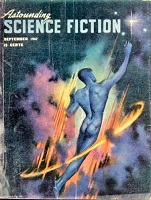
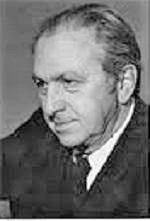 Exploring Tomorrow (1957-58) aired George O. Smith’s “Meddler’s Moon” in early April 1958 as its 25th episode out of an estimated 104. I give the “early” April date from reading the transcript of the show as published for the first time in the George O. Smith collection The Worlds of George O. (more about this further down). A fairly reliable source places the first episode airing on December 4, 1957, with the show airing two episodes per week. I note that there are only approximately 24 episodes in circulation, and that we have run something like 8 of them, the last being way back in August of 2015. Therefore, since it has been two and a half years since that last one, here is the cribbed and much shortened (though still fairly lengthy) introduction to the show, with some interesting new backstory of how this particular episode came to be.
Exploring Tomorrow (1957-58) aired George O. Smith’s “Meddler’s Moon” in early April 1958 as its 25th episode out of an estimated 104. I give the “early” April date from reading the transcript of the show as published for the first time in the George O. Smith collection The Worlds of George O. (more about this further down). A fairly reliable source places the first episode airing on December 4, 1957, with the show airing two episodes per week. I note that there are only approximately 24 episodes in circulation, and that we have run something like 8 of them, the last being way back in August of 2015. Therefore, since it has been two and a half years since that last one, here is the cribbed and much shortened (though still fairly lengthy) introduction to the show, with some interesting new backstory of how this particular episode came to be.
Exploring Tomorrow ran from December 1957 through December 1958 before being cancelled, though some reliable sources have it running into 1959 thanks to its syndication by the AFRTS (American Forces Radio and Television Service, which aired the series for the troops in the European and Pacific theaters). Unfortunately, many of its 104 bi-weekly (Wednesday & Friday) episodes–some repeats–are lost, and of those remaining many are of inferior audio quality unless they have been digitally remastered, which is somewhat expensive.
Exploring Tomorrow‘s sketchy history is indicative of many Old Time Radio shows in regards to the authenticity of its air dates. One of the handful of sources I regularly use in conjunction with other OTR sites is Digital Deli Too. I have found it to be a well researched OTR site (though not perfect). Here is what they have to say (in part) about the number of episodes and air dates circulating around Exploring Tomorrow:
“Given our own extensive research, the papers and recollections of Robert Silverberg, and a few clues in the radioGOLDINdex entries, we’re of the belief that there were in all likelihood an estimated 104 broadcasts of Exploring Tomorrow over the course of its MBS [Mutual Broadcasting Sytem, ed.] syndication. As to the long-touted twenty-eight unique exemplars in circulation, we find that allegation equally suspect. We have twenty-two unique exemplars among our own holdings. We would estimate that we’re actually missing only two of the circulating exemplars, for a total of twenty-four in actual circulation. The Pacific Stars and Stripes listings indicate some fifty or so non-repeating episodes among the AFRTS-denatured recordings. There might well be as many as seventy-eight unique scripts within the Exploring Tomorrow canon–or more. It would also appear that a great many of the commercial Exploring Tomorrow broadcasts were repeats.
“Exploring Tomorrrow was an excellent Sci-Fi offering for the era. Sadly, the OTR Community has so utterly butchered and misrepresented the circulating canon that sorting it all out might take years to come–if ever. Some OTR ‘authority’ apparently pronounced the series as running from December 4th 1957 to June 13th 1958–and that, by gum, was that. There’s just one niggling little problem with that pronouncement—it’s a complete and utter lie. In point of fact, Exploring Tomorrow ran well into December of 1958 throughout America–yet another manifestation of the widely held OTR community’s narcissistic misconception that New York was the epicenter of the Golden Age Radio universe.
“Due to the widespread–and widely condoned–butchery of the circulating recordings, it’s most likely that the overwhelming majority of circulating recordings originated from AFRTS-denatured recordings. Predictably, only the orginating butchers of the circulating exemplars can fully substantiate our surmise–which, given the low bar of integrity throughout the hobby, remains highly unlikely.
“All of the above wouldn’t be so egregious, but for the utter futility of the butchery. To what end? To drive another $300 of commerce to the originating vendor(s)? Bragging rights among other deceptive vendors or collectors? Or simply more childish mischief. The circulating Exploring Tommorow canon is a poster child for all that is wrong with the entirely exploitative ‘OTR’ movement and the swath of historical destruction that the movement has left in its wake.”
With the above in mind, it is buyer beware for those collectors wishing to add to their collections.

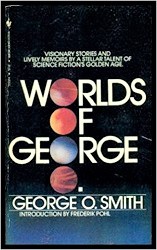 One of the main attractions surrounding Exploring Tomorrow‘s shows (especially now, from an historical perspective) is that it was hosted and narrated by the legendary editor of Astounding Science Fiction (now Analog), John W. Campbell, Jr. (1910-1971), who also added his own commentary during short breaks in each episode. (Photo at left circa 1968.)
One of the main attractions surrounding Exploring Tomorrow‘s shows (especially now, from an historical perspective) is that it was hosted and narrated by the legendary editor of Astounding Science Fiction (now Analog), John W. Campbell, Jr. (1910-1971), who also added his own commentary during short breaks in each episode. (Photo at left circa 1968.)
Now, about “Meddler’s Moon.” It was written by George O. Smith (1911-1981, photo top right) and appeared as a novelette in the September 1947 issue of Astounding SF (cover top left). Smith recounts in his introduction to the story in his 1982 collection The Worlds of George O. (Bantam, 1982, introduction by Frederik Pohl), how the story came to be and which I synopsize here. George was one of Campbell’s regular contributors during Astounding‘s Golden Age of the 1940s. He and John had become friends and hung out fairly regularly. Part of their circle of friends was L. Ron Hubbard. At one of their weekend get-togethers Hubbard called Smith to say that Campbell’s wife Doña would be coming over, and as Smith tells it:
“On one of those weekends, the telephone rang about noon on Sunday. L. Ron said, when he returned, that Doña Campbell was about to come over. Then he eyed me sharply. ‘George, for God’s sake don’t mention dianetics to Doña. If you do, she’ll tell John, and I don’t want John to dive into this as his next hobby until I’m ready to leak it to him myself at the proper moment.’
“Doña had come over to get some peace. John, she said, had discovered “high fidelity,” had built a 50-watt amplifier, and was spending his spare time trying to see how high his fidelity could get out of the old, 78-rpm shellac records of the day. The house, she reported, was reverberating on every floor with John’s 50-watter run at full tilt.”
And a few paragraphs later, Smith continues:
“…Doña escaped the racket from time to time by visiting the Hubbard place, and the four of us would play bridge and have a quiet drink far from John’s cellar and his 50 watts.”
And in the next paragraph Smith gives us the genesis for “Meddler’s Moon”:
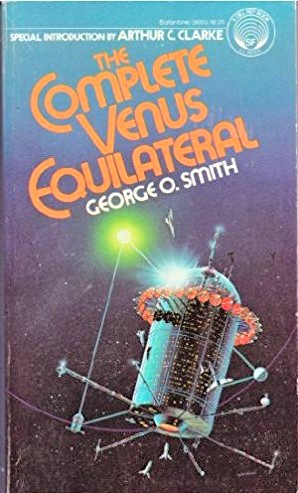 “The time is in the late 1940s, and I’d run Venus, Equilateral into the ground and was looking for new worlds to conquer. In one of our meetings, Doña chuckled over the idea I’d used in “Rat Race” in using a time machine for a mouse trap. [Ed. note: “Rat Race” is one of the stories in The Worlds of George O.] And I replied that mostly, time traveling stories are founded on the idea of “Let’s kill gran-pa!” and what gimmicks the writer could cook up to cover the paradox.
“The time is in the late 1940s, and I’d run Venus, Equilateral into the ground and was looking for new worlds to conquer. In one of our meetings, Doña chuckled over the idea I’d used in “Rat Race” in using a time machine for a mouse trap. [Ed. note: “Rat Race” is one of the stories in The Worlds of George O.] And I replied that mostly, time traveling stories are founded on the idea of “Let’s kill gran-pa!” and what gimmicks the writer could cook up to cover the paradox.
“So it occurred to me that maybe I might play the game backward; that is, instead of killing gran’pa, let’s go back and make sure that gran’pa is protected from one of his intended follies. The following is the answer.”
As to this rewriting of the original 1947 story into a less than half hour radio script, we are quite fortunate that The Worlds of George O. also includes for the first time anywhere, the complete transcript of the show as aired on radio station WOR in April of 1958, to which Smith prefaces his script and tells how he was approached to write the adaptation, and the various requirements of radio he had to take into account with the conversion from print to radio. Needless to say, I recommend the collection for not only the stories it contains from one of the most highly regarded writers in John W. Campbell’s Astounding SF stable during its Golden Age of the 1940s, but equally for the autobiographical prefaces to each story, some running to several pages.
But there’s more to the story surrounding John W. Campbell and George O. Smith and the nearly decade long working and personal relationship between the two. Campbell married Doña Stewart in 1931. The pseudonym he used for some of his own work at the time was Don A. Stuart, derived obviously from his wife’s maiden name. Doña left Campbell in 1949 after eighteen years of marriage for none other than his good friend George O. Smith. George and Doña were married in 1949. That this turnabout strained Campbell’s and Smith’s relationship would be an understatement. Campbell would marry Margaret (Peg) Winter in 1950 and the two remained together until his death in 1971. Thus, I find it a tad odd that Cempbell’s Exploring Tomorrow would seek out Smith to pen the radio adaptation of the story Campbell originally published in 1947. “Meddler’s Moon” would air almost ten years following the awkward situation between the two men, but evidently and at least in some cases, time seems eventually to heal all wounds–at least to a certain extent.
Play Time: 17:42
{April of 1958 saw the neighborhood gang, devoted as ever to their SF pulps, off and running to the corner drugstore on a bright Saturday morning to see what new adventures awaited them. Astounding (1930 to present, now Analog), as always, was a monthly in 1958 and was quickly snatched up as a no-miss regular purchase. Galaxy (1950-1980) featured stories by Clifford Simak and Fritz Leiber so could not be passed up. It was a monthly in 1958, but 1959 saw it go to a bi-monthly. The Original Sciene Fiction Stories (1955-60) was a relative newcomer but promised colorful adventure fare the diehard SF enthusiast never seemed to tire of. It was a bi-monthly through most of its 5-year run.}
[Left: Astounding, April 1958 – Center: Galaxy, April 1958 – Right: Science Fiction Stories, March 1958]
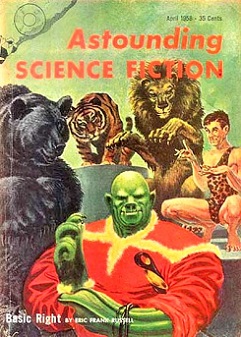
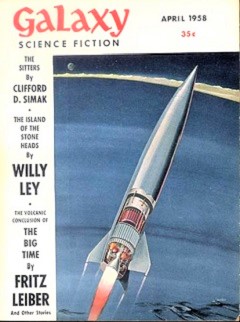
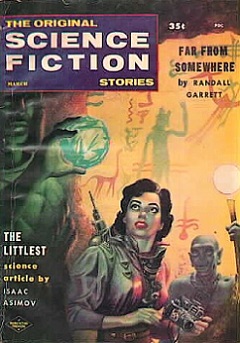
To view the entire list of weekly Old Time Radio episodes at Tangent Online, click here.